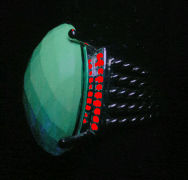What Is Going on With Diamonds?
- Jill Fletcher

- Apr 28
- 3 min read

Prized for the durability, beauty and rarity, diamonds have maintained their value through generations. They convey an eternal commitment through that strength and beauty and have served as enduring signs of love since the 15th century.
We have known about diamonds since their first discovery in India in the 4th century BCE. In 1866, when a young man found a large diamond near the Orange River in Southern Africa, diamond mining began on an industrial scale by Cecil Rhodes, the founder of DeBeers.
Diamonds became available to the middle-class post-World War II. They became more popular for use in engagement rings after the extremely successful DeBeers marketing advertisements which promoted "A Diamond is Forever". In the 1950's diamonds became the most popular gem in an engagement ring.
The diamond market grew, and the US market became the biggest consumer of diamonds.
Then along comes synthetic, laboratory grown, man-made diamonds. GE built a "diamond press" in 1955 and produced a .10 ct. industrial grade diamond. They continued research and in 1970 produced gem quality diamond crystals using their HPHT (high pressure/high temperature method) but it wasn't financially viable due to the cost of production.
There was another process discovered in 1950 that would produce diamonds. CVD, (Chemical Vapor Deposition). It required less pressure and temperature and could be performed with more control over the quality of crystal produced. CVD was refined in the 1980's but with limited production and was also as expensive as the HPHT process, costing tens of thousands of dollars per gem. In the early 2000's the price of lab grown diamonds was $4,000 per carat and then production advancements developed and the price to produce diamonds went to $300 - $400 per carat in the early 2020's. Laboratory grown diamonds started flooding the market. This led to oversupply and further price reductions.
While all this research and discovery was going on in the man-made diamond world, natural diamonds at first maintained their value. Getting a diamond from the ground into a wearable, designed piece of jewelry involves expensive and time-consuming skilled labor. The least expensive way to own a diamond is to receive it as a gift or inherit it. When you purchase a diamond at a jewelry store, many hands have touched that gem before it got to you. Each touch adds value, and you pay for it in the retail price. Does a diamond keep its retail value? It does keep the sentimental value between the giver and the recipient; however, the actual dollar value diminishes once it leaves the store. A natural diamond will hold a percent of its value but not the full retail. The larger the gem and the higher the quality or provenance (think Tiffany, Cartier etc.) the greater the percentage of value retained.
What happened when the man-made diamonds started flooding the market? Quite simply, over supply produced a reduction in prices, both in the man-made and the natural diamonds. Up to 50% reduction in some sizes, shapes and qualities of natural diamond prices year over year. Then the man-made diamonds dropped in price to $100 per carat (wholesale) and they are still dropping.
The issue with man-made diamonds is that they currently do not maintain any value in the secondary market. Jewelry stores who sell them will not take them in trade for a larger gem like they would with a mined diamond. Why? These diamonds can be produced like Swarovski crystals, hundreds at a time. They aren't rare. The photo below shows you red glowing small man-made diamonds being tested under shortwave ultraviolet light. Knowledgeable gemologists can easily detect man-made diamonds.

The diamond market will bifurcate. Consumers who demand the rare and valuable will go for natural diamonds and consumers who are price sensitive will go for man-made diamonds. The markets will stabilize, but they are currently a bit jiggly.
An informed consumer makes a great customer.









Comments